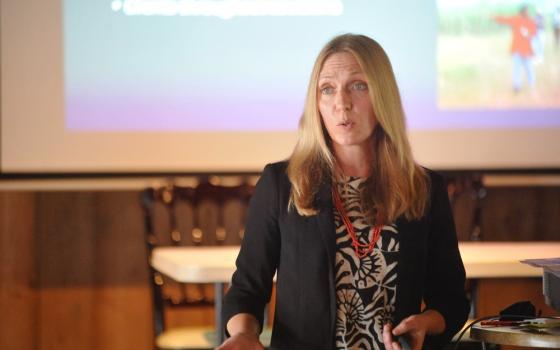Nueva Esperanza, El Salvador -- The road to Nueva Esperanza is dusty and rutted, a bumpy ride for the old pickup truck Gigi Gruenke drove to San Carlos to get me. She knows the roads well from her six years in El Salvador, from 2001 to 2007, as a Maryknoll lay volunteer working with the sisters of the Pequeña Comunidad (“Little Community”) in the Baja Lempe region of the country. She is back to visit and has offered to help me tell the story of the sisters as part of NCR’s coverage of El Salvador 30 years after the death of Archbishop Oscar Romero, who was assassinated on March 24, 1980.
Nueva Esperanza (“New Hope”) has 140 families and is one of the last towns along the Lempe, the country’s main river, which winds snakelike from the Honduran border and empties into the estuaries along Pacific coast 10 miles south of here.
We negotiate around some cattle. A young girl and her brother hitched a ride in the back of the truck when we stopped at a market to pick up 42 eggs. A week of celebrating Monseñor Romero has kept the Pequeña Comunidad sisters busy feeding visitors.
I hold the four stacked cardboard trays tied with string. My arms flex to cushion the eggs at each bump. The children in back sway and hang onto the pipe frame above the truck bed. El Salvador is a place where metaphors spring to mind to help interpret fragile realities. I recall Scott Wright’s story about what it was like to be in the country during its brutal civil war. An activist from Washington, D.C., he had come down in the early 1980s to work in the refugee camps on the Honduran border, then slipped into the country to accompany the thousands of terrified people hiding out in the hills from the helicopter gunships and army patrols. During a stop to rest in the jungle, a woman handed him her baby to hold while she went off to do something. This was El Salvador. If you came here you were entrusted with something precious.
We drop off our riders and park the truck next to the sisters’ walled compound. The town exhibits a rustic simplicity that is also another name for poverty. Across El Salvador, from the urban sprawl in the capital to the tiny cantons in the mountains accessible only on foot, people are living on the edge. Even 18 years after the 1992 peace accords, political divisions and vast inequities still reflect a lack of resources throughout the country, but especially in areas held by the rebels during the war. Malnutrition, no funds for schools or health clinics, and unemployment are forcing young people to head north or join the gangs that pervade even the rural areas.
Accompanying the people
This is where the sisters of the Pequeña Comunidad live and minister to a network of 47 surrounding communities. Their style is immersion with the people and their objective is empowerment. They catechize, do sacramental preparation, counsel -- ordinary ministry -- but with a bottom-up approach made popular 40 years earlier after the Second Vatican Council and the emergence of Christian base communities that emphasized the role of the laity in the church.
We enter the compound where Srs. Nohemy Ortíz, Hortencia Preza and Valentina Pérez join us in a large, covered courtyard with plastic chairs arranged in a circle, an all-purpose space for meetings, meals and prayer. At one end is a garden sculpture of a seated Romero.
Ortíz has been with the community for most of its 40 years. She says that it was “formed in the womb of the Christian base communities” where lay men and women were trained to conduct Bible study in the many outlying villages visited only rarely by priests. The grass-roots vitality of the base community experience attracted young people to the church. Many young women who wanted to commit their lives to service but did not feel called to traditional convent life sought a new form of religious life among the poor. In 1970, the “Little Community” was formed. The sisters did not wear religious habits and did not seek formal status under church law.
Ortíz says that as many as 50 people, both men and women, were involved with the community, but that its vowed membership never exceeded 15. Today, there are a total of eight sisters: the three serving in the Baja Lempe area; two sisters, Ana Beatriz Landaverde and Maria Isabel Figueroa, serving in San Salvador; and three others, Anna María Barriento, Yulma Bonilla and Carmen Elena Hernández, in Morazán. Two North Americans, St. Joseph Sr. Elena Jaramilla from Orange, Calif., and Providence Sr. Frances Stacy from Spokane, Wash., also work with the sisters.
“We never thought of ourselves as an institute or congregation,” Ortíz says. “We were committed to Jesus of Nazareth as his followers and disciples. Rather than take traditional vows to a superior or to a bishop, we take our vows before the people.”
Not having canonical status is outweighed, she says, by the freedom to go where the people need them, and to be prophetic in pursuing justice, even when this is difficult or controversial.
Preza tells of her path to the community; since childhood she had felt a desire to serve but her mother had discouraged her from considering the brown-habited nuns they saw in church. “I joined a choir and youth group where I met Nohemy and some of the other sisters. They didn’t wear habits and I wondered how they could be sisters,” she says. But the more she came to know them and their work with the people, the more she felt called to accompany them. She made her vows in 1989, while the war was still going on. She was 24 years old. “The church became real to me,” she says.
Pérez describes her childhood devotion to her family, but says that she knew she wanted to reach out to others and thought she needed to join the convent to do this. She met Preza, who was holding weekly meetings at her church. “I realized I could dedicate myself to God without going far away to do it. Nohemy kept asking me, ‘When do you want to join us? Come, the door is open.’ ”
Pérez read her vows publicly in 2006. She says that one of the things she values is the sisters’ freedom to reach out to all religious sects and faiths, as Romero had done.
Option for the poor
In its early years, the new community took inspiration from the 1968 Latin American bishops meeting in Medellín, Colombia, where the phrase “God’s option for the poor” was first uttered officially. A new spirit took hold in Latin America, challenging the traditional alignment of the church with wealth and power. In both urban and rural areas, Bible study led to analysis of the causes of poverty, unjust labor practices and land distribution, and the treatment of people by the police and military. Those in power, threatened by growing pressures for reform, accused some priests of being communists, including two Belgian priests who have worked closely with the Pequeña sisters, Frs. Pedro Declercq and Rogelio Ponseele. The struggle pitted conservative bishops tied to the wealthy and the military against the popular church led by Romero, who struggled unsuccessfully to hold both church and nation together to avert civil war, which broke out in 1981.
 The Pequeña sisters, vowed to accompany the people, were caught up in the conflict. One member, Sr. Silvia Maribel Arriola, who made her vows with the group in 1975, is revered as one of El Salvador’s most beloved martyrs. She came to the community because of her desire to serve Jesus in the poor and through her friendship with Ortíz. Arriola was Romero’s personal secretary from 1977 until his assassination in 1980. A nurse, she was with a group of 97 refugees killed by the army on Jan 17, 1981. She was 29 years old. The bodies were doused in gasoline and burned to destroy evidence of the civilian massacre, one of 200 documented from the war.
The Pequeña sisters, vowed to accompany the people, were caught up in the conflict. One member, Sr. Silvia Maribel Arriola, who made her vows with the group in 1975, is revered as one of El Salvador’s most beloved martyrs. She came to the community because of her desire to serve Jesus in the poor and through her friendship with Ortíz. Arriola was Romero’s personal secretary from 1977 until his assassination in 1980. A nurse, she was with a group of 97 refugees killed by the army on Jan 17, 1981. She was 29 years old. The bodies were doused in gasoline and burned to destroy evidence of the civilian massacre, one of 200 documented from the war.
The sisters say they continue to look to Romero for inspiration. Preza and Pérez cite his defense of human rights as the greatest challenge. For Ortíz, Romero remains a model of prophet, teacher and pastor. “He gives us spiritual eyes to see so we can continue to build the reign of God,” she says. “He is now a risen in the people.
“Everyone wants him to be canonized, but not just as an object of devotion, someone to light candles to. He lived his life in total faithfulness during a very crucial moment in El Salvador’s history. We will honor him by living as he did, saying what he said. And that is not so easy.”
[Pat Marrin is the editor of Celebration, the worship resource of the National Catholic Reporter.]
On the Web
Visit www.share-elsalvador.org for information about a Nov. 9-Dec. 6 commemoration of the women martyrs of El Salvador.



